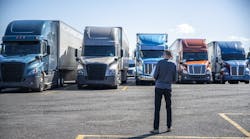Managing human resources in the trucking industry can be tricky, especially for small fleets.
Having worked with different types of fleets across North America, I’ve come to recognize why trucking historically lacks an HR practice that caters to its own unique needs.
As a former owner-operator, I’ve seen firsthand that many of the trucks on the road today are the result of an owner-operator or small fleet owner who grew their fleet organically. They’ll add a few trucks, then add some office staff to support operations, and repeat the process. At some point, someone will be appointed to lead fleet safety because the company needs a person to make sure compliance is managed, and driver files are in place. Bit by bit, this person often takes on the high-level responsibilities of an HR professional, eventually learning the key practices tied to human resource management.
See also: The impact of TMS on driver success
Having worked with fleets for years to simplify day-to-day business activities, I know it can take time for those new to the industry to truly understand how trucking companies operate. Even if they know about company policy, workplace safety, and other office management duties, there’s a lot to learn about the unique challenges of HR management in the industry. As a result, there can be a gap in knowledge between knowing the ins-and-outs of a trucking operation and best HR practices. Both skill sets need to complement each other to roll out an effective HR strategy.
For those with plenty of industry experience, but new to managing people, there are a number of services and technologies available that can help with HR, driver safety, recruiting, onboarding, and other business tasks.
When a fleet has grown to the point where a structured HR approach is needed, generally about 50 drivers, it’s important for the person taking on the responsibility of HR to figure out what the company’s onboarding, health, and safety policies will look like. From there, they can work out HR-specific tasks and how they will support other operational objectives.
Larger fleets have historically been the first to implement new software for managing HR-related tasks, but that’s changing. I recently did a webinar with Mark Murrell, president and co-founder of CarriersEdge, who said he’s witnessed a shift in progressive thinking. He’s seen smaller fleets that have participated in the Best Fleets to Drive For program become more proactive in integrating new technologies. The program is put on by CarriersEdge and the Truckload Carriers Association each year to determine top workplaces for drivers.
While the trucking industry has previously lacked back-office experience with software implementation, these days, there are many software systems coming into play and tools available to help with different driver tasks like HR, training, driver scorecards and telematics.
Today’s software offerings make it easier than ever for fleets to manage employee-related tasks like HR and driver training. However, without taking the necessary steps to integrate online tools effectively, the software will turn into unused “shelfware” with little attention paid to its possibilities. You can’t just add new software to your business practices and expect it to deliver results like a new trailer skirt or a set of air brakes.
See also: There’s an app for that
There’s always a learning curve when it comes to knowing how to properly use new software. Implementing it takes time and focus to understand how it will be received and used by office staff and drivers. That’s why, depending on the size of the fleet, you should do a soft (or pilot) rollout with select drivers. That way you can monitor any questions that come up, develop the full tutorial on how to use the technology, and be confident when a full rollout happens. Remember not to overwhelm drivers. Typically, you shouldn’t introduce more than one new system at a time.
Murrell best explained the relationship between implementing new software and the effectiveness of its rollout from leadership. “Any software, no matter how intuitive, is only as good as a fleet’s leadership,” he said. “Great leadership can effectively communicate and show employees how new integrations will make their jobs easier.”
Ultimately, the key to a successful implementation of new HR practices is having a fleet that’s willing to evaluate its current practices, identify shortcomings, and work to find solutions that resolve the problematic areas. All in a way that isn’t overwhelming to the people the changes will affect most.
Dirk Kupar and his wife, Lisa, launched their software company, TruckRight, in 2014. As multi-truck owner/operators and proprietors of an international truck driver leasing company, the couple has since provided a cloud-based, paperless workflow designed to keep fleets engaged, safe, and compliant.



